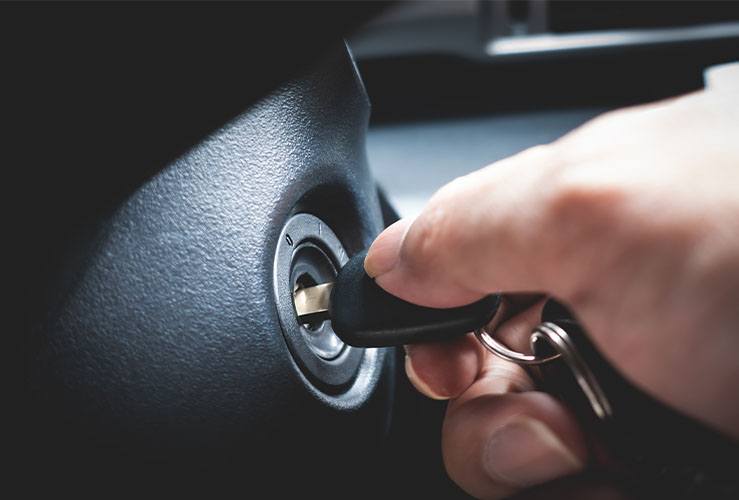Most drivers will experience a flooded engine at some point - probably more than once. It's a common breakdown cause that often prompts motorists to call their roadside assistance providers.
Find out why petrol engines can flood, how to fix the problem and recognising the three main signs of a flooded engine in more detail below:
Recognising Symptoms of a Flooded Engine: What to Look For
Drivers may notice tell-tale signs of a flooded engine, such as:
- A strong smell of petrol around the vehicle, particularly near the exhaust or engine bay
- A rapid cranking or ‘whirring’ sound during ignition that sounds faster than usual
- The engine won’t start at all, or it starts briefly but cuts out immediately afterwards
Understanding what to do if you flood your engine can save you from unnecessary delays and repair costs.
NB: this article does not discuss solving the problem of a water-flooded engine, which is potentially a far more serious (i.e. expensive) issue.

What is a flooded engine?
A flooded engine occurs when too much fuel enters the engine's combustion chamber, overwhelming its capacity to ignite properly. This typically leaves the spark plugs wet, preventing effective ignition.
It's most common in petrol engines, particularly older vehicles or vehicles with carburettors. It’s less common for modern fuel-injected engines to flood but it can still happen.
A flooded engine is particularly common during colder months when engines require extra fuel for cold starts.
What are the signs your petrol engine is flooded?
Drivers may notice tell-tale signs of a flooded engine, such as a strong smell of petrol, a rapid cranking sound during ignition, or an engine that starts briefly but stalls soon after.
Understanding what to do if you flood your engine can save you from unnecessary delays and repair costs.
How does a petrol engine flood?
A petrol engine can flood when it is started and then switched off very soon afterwards - often in colder months. It happens because extra fuel is needed when an engine is started from cold, leaving unburned fuel in the engine when the ignition is turned off.
This makes the spark plugs wet, which can mean the ignition no longer works - and the car won't start.
The "bore wash" factor
The presence of petrol can "wash" the oil off the cylinder's piston rings - thereby reducing compression. As a result, the engine runs more quickly and can sound different to normal.
- You may hear a faster cranking or an unusual sound during ignition attempts.
- The engine may run irregularly or fail to start entirely.
This lack of lubrication can also contribute to wear and tear on the engine, so addressing a flooded engine promptly is essential. Understanding how to start a flooded engine and taking proper preventive steps can mitigate these risks.
What scenarios are likely to cause a flooded car engine?
When you take very short trips in your car - particularly when it's cold - your engine is more likely to flood. Examples include taking a quick trip to the shops, or moving your car out of the garage.
Are some cars more susceptible to engine flooding?
Any type of petrol engine can suffer flooding, but smaller, four-cylinder engines are notably more susceptible.
Flooded car engine: Here's how to fix it
The following approach to fixing a flooded engine should only be attempted after you have closed your home's windows and doors, because your engine will produce a great deal of smoke from the exhaust.
If you're doing this in the garage, ensure the door is open so the smoke can escape.
- With the accelerator pedal depressed, try to start your engine.
- Try cranking your engine in short periods of up to 10 seconds - until the engine starts up.
- With the engine ticking over, let it rev up a little, then maintain a higher-than-normal idle speed for several seconds.
- Having warmed up the engine, you're ready to either drive off, or switch off.
If your engine still doesn't start after a few attempts, a flooded engine may not be the culprit.
Will a flooded engine fix itself? It might not. Without taking steps to burn off the excess fuel, the engine is unlikely to recover on its own, leaving you stranded. Understanding what to do if you flood your engine is critical in such situations.
Flooded engine: avoiding it in the first place
You will virtually eliminate the chances of a flooded engine if you warm it up before setting off.
This issue is worse in colder months when the engine temperature has further to rise to be properly warmed up.
How do I know my engine has warmed up?
The idle speed will drop or settle slightly once the engine is warmed up. The temp gauge will also move up from the minimum mark.
Frequently Asked Questions
‘Bore wash’ happens when excess unburned fuel removes the vital oil coating from the cylinder walls. This reduces compression, makes starting harder, and increases engine wear. It’s important to avoid repeated flooding to protect your engine’s long-term health.
If your car often struggles to start or repeatedly floods, it’s wise to have it inspected by a professional mechanic. Persistent issues could indicate worn spark plugs, faulty sensors, or other underlying problems. Getting it checked promptly can prevent costly repairs later on.




